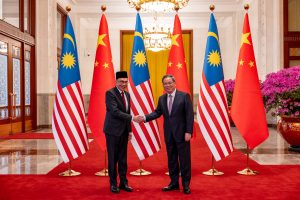During a recent trip to China, Malaysian Prime Minister Anwar Ibrahim announced that he had secured 19 memoranda of understanding from Chinese entities reflecting an investment commitment of RM 170 billion ($38.5 billion). This sounds impressive, but investment commitments should always be taken with a grain of salt as they are rarely legally binding and tend to be as much about political signaling as anything else. The hard yards are measured by realized investment and what Malaysia might actually get from these projects. A quick look at the recent past can give us some idea of how the new commitments stack up against historical trends.
According to the Asian Development Bank, fixed capital formation in Malaysia began faltering toward the end of the 2010s, falling from 26 percent of GDP in 2016 to 21 percent in 2019. Data from the World Bank shows that during that time net inflows of foreign investment were also declining, from a high of $15 billion in 2011 to $9 billion in 2019. What this tells us is that by 2019, just prior to the onset of the COVID-19 pandemic, investment activity as well as inflows of foreign capital were on the wane.
Foreign direct investment bounced back strongly during the pandemic, with net inflows surging to a high of $18.6 billion in 2021. The pandemic did unusual things to the global distribution of capital by, among other things, pushing down interest rates and shifting investment into economies where yields were thought to be higher. It seems Malaysia may have been one of them, as hot money flows started arriving in 2021. The timing was good because, as the data referenced above shows, investment activity was slowing down.
According to the Malaysian Investment Development Authority, this trend continued into 2022 with RM 264.6 billion ($60 billion) in total investment approvals, 62 percent from foreign sources. Of that, China was overwhelmingly the top investor, accounting for RM 55.4 billion ($12.5 billion), almost twice as much as the second-place investor, the United States. Approved foreign investment projects were primarily in information and communication, mining, transport equipment, and chemical industries. I should note that to the best of my understanding, this represents approved rather than realized investment so some of this may not actually materialize. But the trend itself is telling.
Even planned foreign investment at this scale is a relatively new phenomenon, as prior to 2021 between 20 to 40 percent of approvals were for foreign funded projects, with the rest coming from domestic sources. If we look at 2019, for instance, approvals reached RM 211.4 billion ($48 billion), 60 percent of which was domestic investment. In 2021, this relationship was inverted, with foreign investment commitments shooting up to RM 208.6 billion ($47 billion), 67 percent of the total.
Now that yields are rising in places like the United States, the question is whether Malaysia was the beneficiary of a one-off inflow of foreign investment due to unusual pandemic-era capital market conditions, or whether it can sustain this wave of foreign investment. It is too early to say, and the precise sectors these foreign inflows are being invested in and how that will shape long-term economic growth is another important question we need to be asking. But for now, I think part of the signal that Anwar intended to send by going to China and securing large commitments is that foreign investment, of which China has been a major source, is here to stay.

































